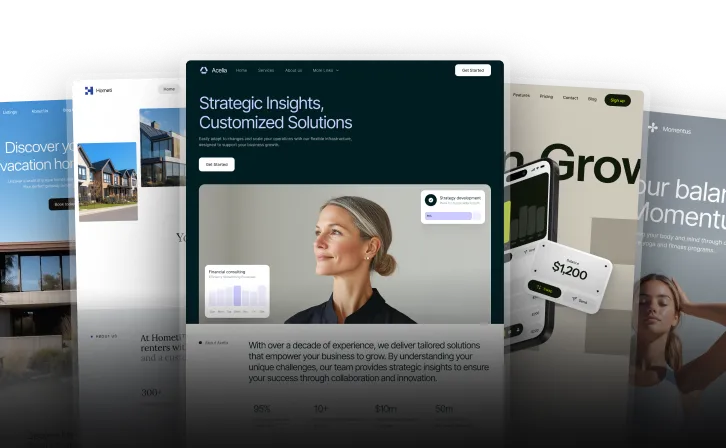Webflow vs Shopify: Which Website Builder is Right for You
Unlock all templates




Choosing between Webflow and Shopify? Here's the quick answer:
- Webflow: Best for design-focused businesses that want full creative control and advanced customization. Ideal for unique branding and marketing sites.
- Shopify: Perfect for e-commerce businesses needing easy setup, advanced inventory tools, and seamless payment/shipping options.
Quick Comparison
| Feature | Webflow | Shopify |
|---|---|---|
| Best For | Design-driven brands, marketers, and SaaS companies | E-commerce businesses, small to large-scale stores |
| Ease of Use | Steeper learning curve | Beginner-friendly, quick setup |
| Design Control | Full customization, advanced animations | Template-based, limited customization |
| E-commerce Features | Basic inventory, requires third-party integrations | Advanced tools, built-in inventory management |
| Payment Options | Stripe, PayPal (2% fee on lower plans) | Shopify Payments (no extra fees), 100+ gateways |
| Pricing | Starts at $29/month | Starts at $19/month |
Summary: If you prioritize design flexibility, go with Webflow. For a hassle-free e-commerce experience, Shopify is the way to go.
Webflow vs Shopify (2024) - Which is Better?

Getting Started
Before diving into the design tools and features of each platform, it's important to understand how easy they are to learn and set up.
Time to Learn
Shopify's drag-and-drop editor makes it possible for beginners to create a store in just a few hours. In fact, most users can have a basic Shopify store up and running within a day. On the other hand, Webflow has a steeper learning curve. While it offers a quick five-minute introductory tutorial, fully grasping its website builder and CMS requires a more significant time investment.
Setup and Controls
Shopify simplifies the setup process with an onboarding checklist that guides users step-by-step. It also separates tools for managing your store's appearance and handling products, making it approachable for new users.
"What compelled us to go with Shopify over the others was how intuitive it is... Some of those other solutions are more segmented, but Shopify checked off significantly more boxes for us. Being the bootstrap entrepreneurs that we were at the time, it made more sense for us to reduce as much overhead as we possibly could."
Webflow, on the other hand, is designed for users with experience in design or development. Its dashboard resembles professional web development tools, offering advanced customization options for those ready to put in the effort.
Here’s a quick comparison of key interface differences:
- Editor Type: Shopify uses a WYSIWYG editor, while Webflow offers visual development tools.
- Dashboard Layout: Shopify focuses on task-oriented simplicity, whereas Webflow caters to designers with detailed controls.
- Initial Guidance: Shopify provides a step-by-step checklist; Webflow offers a tutorial supported by documentation.
- Template Customization: Shopify allows for basic tweaks, while Webflow gives you full creative control over design.
Next, we’ll dive into how these setup and learning differences influence the design capabilities of each platform.
Design Options
Templates and Design Tools
Webflow offers a marketplace with over 500 templates and a visual editor that lets you control every design element. Shopify, on the other hand, provides ten free e-commerce themes designed to boost conversions, along with additional premium options.
For example, Webflow's Montreal template, tailored for SaaS, stands out with its bold hero sections, smooth animations, and gradient designs, showcasing the platform's ability to deliver visually stunning results.
Here’s a quick comparison of their design features:
| Feature | Webflow | Shopify |
|---|---|---|
| Template Variety | 500+ templates for various industries | 10 free themes plus premium themes |
| Design Quality | Sleek, modern designs | Professional, conversion-focused layouts |
| Template Switching | Requires more effort | Simple and quick |
| Mobile Responsiveness | Built-in tools for responsive design | Automatic mobile optimization |
| Animation Capabilities | Advanced animations like parallax effects | Basic hover effects and transitions |
Now, let’s dive into how their design control options can influence the uniqueness of your site.
Custom Design Control
When it comes to customization, Webflow and Shopify take very different approaches. Webflow is all about giving users complete creative freedom without needing coding skills. You can build unique storefronts, customize your cart and checkout process, and even add advanced animations like parallax scrolling or multi-step effects.
Shopify, however, leans toward a more structured system. While you don’t need coding knowledge to get started, advanced tweaks often require familiarity with the Liquid template language. Shopify also offers UI extensions to help merchants craft personalized checkout experiences.
Here’s a breakdown of what each platform offers:
- Webflow gives you precise control over:
- Layout and positioning
- Typography and spacing
- Custom animations
- Responsive design adjustments
- Cart and checkout customization
- Shopify focuses on simpler customization through:
- Theme settings for colors and fonts
- Pre-designed responsive layouts
For businesses aiming to stand out, Webflow's templates, like the Frankfurt template, are perfect for highlighting product features and case studies while maintaining fast performance. On the flip side, Shopify is ideal for those who prioritize a quicker setup with proven, conversion-ready designs. This difference boils down to whether you value creative flexibility or a streamlined design process.
sbb-itb-fdf3c56
Online Store Features
Store and Stock Management
Shopify and Webflow handle inventory management in distinct ways. Shopify provides built-in tools to monitor stock levels, set low-stock alerts, and generate reports - all accessible through a centralized dashboard.
For businesses with more advanced needs, Shopify's Stocky app (designed for Shopify POS users) offers additional functionality tailored for more complex inventory management.
Webflow, on the other hand, includes a straightforward site management dashboard. However, advanced inventory tracking requires third-party integrations. For example, businesses can connect Webflow to Zoho Inventory using Zapier or create custom inventory systems by combining Webflow with tools like Wized and Xano.
Here's a quick comparison of store management features:
| Feature | Shopify | Webflow |
|---|---|---|
| Built-in Inventory Tracking | Detailed | Basic |
| Stock Alerts | Automated | Requires integrations |
| Multi-channel Management | Centralized | Limited |
| Custom Inventory Solutions | Apps like Stocky | Third-party tools |
Let’s now explore how these platforms handle payments and shipping.
Payments and Shipping
When it comes to payments, Shopify and Webflow take different approaches. Webflow integrates with Stripe and PayPal, applying a 2% transaction fee on its Ecommerce Standard plan, which drops to 0% on higher-tier plans. Shopify, meanwhile, offers its own Shopify Payments system, alongside support for third-party providers. By using Shopify Payments, Shop Pay, or PayPal Express, merchants avoid additional transaction fees. Both platforms still incur standard processing fees from providers like Stripe and PayPal, typically 2.9% + $0.30 per transaction.
For shipping, Webflow connects with tools like Shippo and ShipStation. These integrations let merchants sync orders, create shipping labels, and automate order tracking.
Shopify takes it a step further with its Shopify Fulfillment Network (SFN) and integration with Flexport. This setup gives merchants access to distribution hubs, fulfillment centers, and a variety of shipping options. These include direct-to-consumer fulfillment, B2B wholesale distribution, and international shipping. For example, Kizik leveraged Shopify’s Flexport integration to improve delivery times and uncover growth opportunities.
Cost Breakdown
When choosing between Webflow and Shopify, it's essential to look beyond design and features. Pricing and additional costs can significantly impact your decision.
Plan Options
Webflow and Shopify take different approaches to pricing. Webflow separates its plans into Site and Ecommerce categories, while Shopify combines website and store functionalities into unified plans.
Webflow's Ecommerce plans (billed yearly):
- Standard: $29/month, includes 500 ecommerce items and 2,000 CMS items (2% transaction fee).
- Plus: $74/month, supports 5,000 ecommerce items and 10,000 CMS items (no transaction fee).
- Advanced: $212/month, allows 15,000 ecommerce items and 10,000 CMS items (no transaction fee).
Shopify's core plans (billed yearly):
- Basic: $19/month, includes 10 inventory locations and 24/7 chat support.
- Shopify: $49/month, offers more staff accounts and lower transaction rates.
- Advanced: $259/month, provides enhanced support and 10× checkout capacity.
For small businesses, Shopify also has a Starter plan at $5/month, ideal for basic selling needs. At the enterprise level, Shopify Plus starts at $2,300/month (on a three-year term), while Webflow Enterprise pricing is customized based on your specific requirements.
When deciding, weigh these pricing structures against your business's design and functionality needs.
Extra Costs
Both platforms come with additional expenses beyond the base plans. With Webflow, you'll need both a Site plan and a Workspace plan, which adds to the upfront cost before considering ecommerce-specific features.
- Webflow's Standard plan includes a 2% transaction fee, but this is waived on higher-tier plans.
- Shopify avoids transaction fees if you use Shopify Payments, but fees apply when using third-party payment gateways.
Shopify's app store offers a wide range of tools to expand functionality, while Webflow often depends on third-party integrations like Zapier. These integrations typically cost $20 to $50 per month, depending on the service and usage. Be sure to account for these additional costs when comparing the two platforms.
Feature Comparison
Here's a side-by-side look at the key features of Webflow and Shopify to help you better understand their strengths.
| Feature Category | Webflow | Shopify |
|---|---|---|
| Design Control | Full visual customization without coding, custom animations, and no template restrictions | Template-based designs with limited customization; advanced changes require Liquid coding |
| E-commerce Capacity | Supports up to 15,000 products on the Advanced plan with basic inventory tracking | Unlimited products with advanced inventory management across multiple locations |
| Payment Options | Works with Stripe, PayPal, and Apple Pay | Supports over 100 payment gateways, including Shopify Payments |
| Shipping Features | Manual shipping rates; advanced options need third-party integrations | Built-in shipping label printing, carrier partnerships, and automated shipping rates |
| Product Management | Basic product organization with limited variant options | Advanced variant management, bulk import, and detailed collection organization |
| Multi-channel Selling | Requires third-party integrations | Native integration with social media and online marketplaces |
This table highlights the contrasting approaches of the two platforms. Webflow focuses on giving users total control over their design, making it ideal for those who want to craft unique and visually striking websites.
On the other hand, Shopify shines when it comes to managing complex product catalogs, inventory, and shipping. Its broad range of payment gateways ensures it’s ready for global commerce.
Webflow is a great choice for:
- Design-driven brands that want complete creative control
- Projects needing custom animations and interactions
- Businesses focused on standing out through design
Shopify is ideal for:
- E-commerce businesses requiring advanced tools
- Companies with large inventories and complex product needs
- Merchants looking for seamless payment and shipping options
Shopify also offers built-in, ready-to-use third-party integrations, while Webflow's integrations often need some technical setup. When it comes to scalability, Shopify offers a clear path for growth, from small businesses to enterprise-level operations. Webflow, on the other hand, centers its strengths on design and content management.
Up next, let’s identify which platform aligns best with your business goals.
Which Platform to Choose
Deciding between platforms? Here's a breakdown to help you find the best fit for your needs.
For E-commerce-First Businesses
If your focus is selling physical products, Shopify is a top choice. Big names like Gymshark, Heinz, and Kylie Cosmetics rely on Shopify for its powerful e-commerce features. It offers tools like advanced inventory management (supporting up to 2,000 product variants per item), built-in shipping label printing, and automated shipping calculations.
Now, if your priorities lean more toward design and content, there’s another option.
For Design and Content-Focused Businesses
Webflow stands out for its flexibility in design and its robust CMS, making it ideal for unique branding. It’s a favorite among creative agencies, SaaS companies, and content-driven brands thanks to its advanced design tools.
A Hybrid Approach
Need the best of both worlds? Use Webflow to create visually stunning landing pages and integrate Shopify’s Buy Button for seamless checkout functionality. This combo gives you creative freedom while keeping e-commerce simple.
Budget Options
Here’s a quick guide based on budget and business size:
- Small Business/Startup: Go with Webflow Basic for affordability and customization.
- Growing E-commerce: Shopify’s scaling plans are designed to grow with your business.
- Enterprise: Shopify Plus offers enterprise-level solutions.
Keep in mind that while Webflow allows for more customization, it has a steeper learning curve. Shopify, on the other hand, is easier to use and delivers functionality right out of the box. Choose the platform that aligns with your team's skills and long-term vision.
Related Blog Posts
Recommended posts
Unlock all templates







